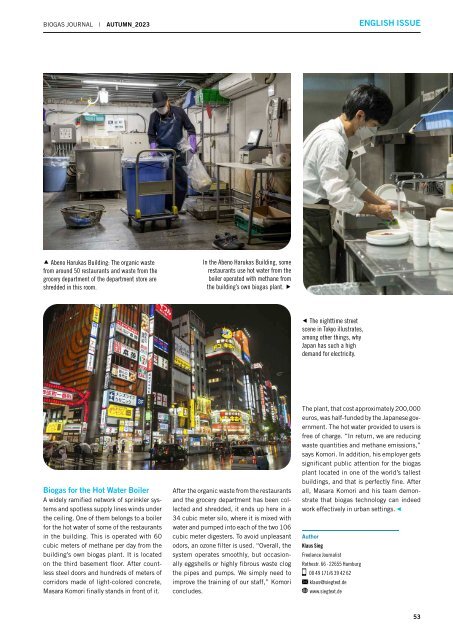Autumn 2023 EN
The German Biogas Association presents its autumn 2023 issue of the English BIOGAS journal.
The German Biogas Association presents its autumn 2023 issue of the English BIOGAS journal.
- No tags were found...
Create successful ePaper yourself
Turn your PDF publications into a flip-book with our unique Google optimized e-Paper software.
BIOGAS JOURNAL | AUTUMN_<strong>2023</strong> <strong>EN</strong>GLISH ISSUE<br />
Abeno Harukas Building: The organic waste<br />
from around 50 restaurants and waste from the<br />
grocery department of the department store are<br />
shredded in this room.<br />
In the Abeno Harukas Building, some<br />
restaurants use hot water from the<br />
boiler operated with methane from<br />
the building’s own biogas plant. <br />
The nighttime street<br />
scene in Tokyo illustrates,<br />
among other things, why<br />
Japan has such a high<br />
demand for electricity.<br />
Biogas for the Hot Water Boiler<br />
A widely ramified network of sprinkler systems<br />
and spotless supply lines winds under<br />
the ceiling. One of them belongs to a boiler<br />
for the hot water of some of the restaurants<br />
in the building. This is operated with 60<br />
cubic meters of methane per day from the<br />
building’s own biogas plant. It is located<br />
on the third basement floor. After countless<br />
steel doors and hundreds of meters of<br />
corridors made of light-colored concrete,<br />
Masara Komori finally stands in front of it.<br />
After the organic waste from the restaurants<br />
and the grocery department has been collected<br />
and shredded, it ends up here in a<br />
34 cubic meter silo, where it is mixed with<br />
water and pumped into each of the two 106<br />
cubic meter digesters. To avoid unpleasant<br />
odors, an ozone filter is used. “Overall, the<br />
system operates smoothly, but occasionally<br />
eggshells or highly fibrous waste clog<br />
the pipes and pumps. We simply need to<br />
improve the training of our staff,” Komori<br />
concludes.<br />
The plant, that cost approximately 200,000<br />
euros, was half-funded by the Japanese government.<br />
The hot water provided to users is<br />
free of charge. “In return, we are reducing<br />
waste quantities and methane emissions,”<br />
says Komori. In addition, his employer gets<br />
significant public attention for the biogas<br />
plant located in one of the world’s tallest<br />
buildings, and that is perfectly fine. After<br />
all, Masara Komori and his team demonstrate<br />
that biogas technology can indeed<br />
work effectively in urban settings.<br />
Author<br />
Klaus Sieg<br />
Freelance Journalist<br />
Rothestr. 66 · 22655 Hamburg<br />
00 49 171/6 39 42 62<br />
klaus@siegtext.de<br />
www.siegtext.de<br />
53

















